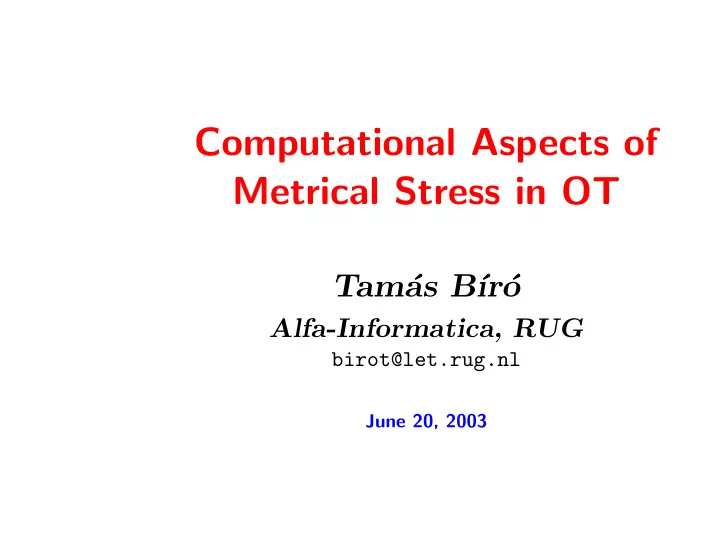

Computational Aspects of Metrical Stress in OT Tam´ as B´ ır´ o Alfa-Informatica, RUG birot@let.rug.nl June 20, 2003
1
2 Overview • What is a finite state transducer (FST)? • Finite state transducers and regular grammars • OT as a FST: Is Gen a FST? Are constraints FSTs?
3 What is a finite state transducer? A mapping: a x b y input string − − → FST in state S − − → output string c x a z d y • A finite set of states • A finite set of transition rules: ( actual state , input ) �− → ( new state , output )
4 Grammatical: � � I love you! � � � � Beer! Beer! Here you are! Am I a servant? Do you? � � I love you � � � � Beer! Beer! That’s not nice That’s not nice So do I! Agrammatical: � � I love you! � � I love you! � � Beer! ∗ Here you are! Do you? I don’t!
5 Finite state transducers and regular grammars • Finite state transducers • Regular grammars • Regular expressions have the same generative power Remember: regular ⊂ context-free ⊂ context-sensitive
6 � � Beer! lover − → lover Here you are, my dear. � � Beer! lover − → avarage Here your are! � I love you! � very angry − → angry I don’t.
7 Finite state transducers as language models: Why usually men fail if they apply this model? What is the problem with this model? no long-term memory !!! • This is a very strong restriction on the model. • Can you describe human language with such a restricted model?
8 Phonology as a finite state transducer SPE 1968: context sensitive rules (too powerful) Johnson 1972, Koskenniemi 1983, Kaplan and Kay 1994, etc: most of phonology has a generative power of a regular language. Prince & Smolensky 1993: • Is OT an adequate model for phonology?
9 OT as a finite state transducer • If yes, can one implement it as an FST? • Implement Gen as an FST • Implement the constraints as FSTs
10 Implement Gen a finite state transducer? Well... Which Gen? Say: metrical stress. word = � unprsd syl � unprsd syl � � ∗ � � � ∗ � � � � � # � # � hd-ft � � � � n-hd-ft n-hd-ft � � � � � �
11 Implement Gen a FST? (cont’d) unprsd syl = phonemes ∗ | . n-hd-ft = phonemes ∗ | 2 | . phonemes ∗ | 2 | . | phonemes ∗ | . phonemes ∗ | . | phonemes ∗ | 2 | .
12 Implement Gen a FST? (cont’d) hd-ft = phonemes ∗ | 1 | . phonemes ∗ | 1 | . | phonemes ∗ | . phonemes ∗ | . | phonemes ∗ | 1 | . • Transform regular expressions to FST
13 # ab.ra.ka.dab.ra.# ↓ FST in state S ↓ # ab. { ra.ka1 } .[dab2.ra].#
14 Are constraints finite state transducers? Depends...
15 Are constraints finite state transducers? (cont’d) A typology for constraints: The maximal number of violation marks that a candidate can be assigned is: 1. 1 (or: constant in the length of the word) 2. proportional to the length of the word 3. growing faster than the length of the word
16 Are constraints finite state transducers? (cont’d) Case 1: Max. 1 (constant) violation mark for each candidate. Example: • ALIGN(Word,Foot,Left): align the left edge of the word with the left edge of some foot. Easy to realize with finite state techniques. (Frank and Satta 1998, Karttunen 1998).
17 Remark: Max. 1 violation mark, but not Finite State-friendly constraints (not possible to assign violation marks): MatchesOutputOfSPE : The output matches the result of applying Chomsky & Halle (1968) to the input. (J. Eisner, 1999) Cf. OTP : “OT with primitive constraints” by J. Eisner.
18 Are constraints finite state transducers? (cont’d) Case 2: Number of violation marks proportional to the length of the word Case 2a: Violation marks align nicely: • ALIGN(Main-foot,Word,Left): align head-foot with word, left edge. σ ∗ σ ∗ σ ∗ [ σ σ 1] σ σ Possible to realize using finite state techniques. (Gerdemann and van Noord 2000, B´ ır´ o 2003)
19 Are constraints finite state transducers? (cont’d) Case 2b: 1 (constant) violation per locus, but anywhere. Examples: • Parse-syllable: each syllable must be footed. • Iambic: align the right edge of each foot with its head syllable. Easy to assign the violation marks, but hard to filter out the non-harmonic candidates.
20 Are constraints finite state transducers? (cont’d) Case 3: Number of violation marks growing faster than the lengths of the string. Example: • ALIGN(Foot,Word,Left): align each foot with the word, left edge. (Usually) not possible even to write a transducer that would assign the violation marks. (B´ ır´ o 2003, cf. J. Eisner’s remarks)
21 Conclusions Message for phonologists: • OT’s power can be close to the very restricted class of regular languages, • if you don’t use certain constraints, • such as gradient constraints. • Cf. McCarthy’s recent arguments against them.
22 Conclusions Hypotheses underlying OT (explicit in McCarthy 2002) : • Locus hypothesis : A violation mark is assigned for each locus of violation within a candidate. • Gradience hypothesis : Some constraints are gradient: multiple violations to a single locus. • Homogeneity hypothesis : Multiple violations of a constraint from either source are added together in evaluating a candidate.
23 Conclusions McCarthy: no need for gradient constraints. Reformulate them or throw them! Gradient constraints that cannot be reformulated: • “harmful” according to McCarthy (2002), • impossible for a finite state approach (too strong generative power needed)
24 Conclusions Otherwise you can be optimistic about a harmonic marriage of OT and FST. { Beer! I love you! }
Recommend
More recommend